Baar Baar Dekho Hazaar Baar Dekho – Shakti Samanta
- K V Ramesh | kvr4060@gmail.com
If one were to look at the sheer volume of work of Shakti Samanta, we would be astounded by the high quality of songs in his films. And what songs they were; memorable is an understatement to describe the sheer high quality of output, leave alone the commercial successes. Shakti Samanta clearly understood that to have a hit, you needed good music. His almost forty-year career had many memorable films with superhit music that was finely woven into the film’s overall theme or forwarded the story. Be it crime thrillers, socially driven films, or pure entertainment sans any social message, Samanta did them all in absolute musical style.
Born in Burdhaman, present-day West Bengal, in 1926, Samanta joined the film industry in 1948 as an assistant director. Serving under Phani Majumdar and Gyan Mukherjee, he learned his craft. The apprenticeship proved valuable when he became an independent director with Bahu (1955). Different films with different themes followed: crime drama Inspector (1956), romance with Hill Station (1957), and another crime drama Sheroo (1958), which had a lilting Lata hit Nainon me pyaar doley dilka karaar doley.
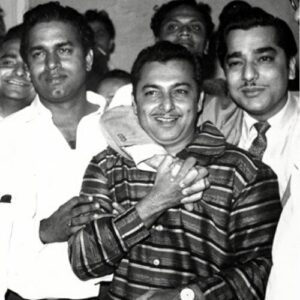 Samanta turned producer with Howrah Bridge (1958), a crime drama about a statue smuggled from Burma. It was a huge hit, no doubt helped by the suaveness of Ashok Kumar (a real-life chain smoker) blowing cigarette smoke nonchalantly. At the same time, he looked at a sensuous Madhubala crooning first Dekhke Teri Nazar and then Aaiye Mehrbaan. Even if anyone sees Aaiye Mehrbaan in isolation, it is evident that the Anglo-Indian Edna (Madhubala) is deliberately rejecting the villain Pyarelal (K.N.Singh) and choosing to dance with a surprised Prem (Ashok Kumar). This one song alone overshadows all the other worthy O.P. Nayyar compositions in the film, which was shot entirely in Calcutta (now Kolkata). The film’s success was ensured by the outdoor locales and the climax set and picturized on the magnificent Howrah Bridge.
Samanta turned producer with Howrah Bridge (1958), a crime drama about a statue smuggled from Burma. It was a huge hit, no doubt helped by the suaveness of Ashok Kumar (a real-life chain smoker) blowing cigarette smoke nonchalantly. At the same time, he looked at a sensuous Madhubala crooning first Dekhke Teri Nazar and then Aaiye Mehrbaan. Even if anyone sees Aaiye Mehrbaan in isolation, it is evident that the Anglo-Indian Edna (Madhubala) is deliberately rejecting the villain Pyarelal (K.N.Singh) and choosing to dance with a surprised Prem (Ashok Kumar). This one song alone overshadows all the other worthy O.P. Nayyar compositions in the film, which was shot entirely in Calcutta (now Kolkata). The film’s success was ensured by the outdoor locales and the climax set and picturized on the magnificent Howrah Bridge.
The film industry is all about trends and repeating them. The crime drama Detective (1958) was not successful even though it boasted some brilliant music by Mukul Roy. The Rafi-Sudha Malhotra duet Aankhon pe bharosa mat kar, the Hemant-Geeta Dutt duet Mujhko tum jo Miley, and the soulful Geeta Dutt solo Do chamakti aankhon ne were all good and still are popular with music enthusiasts.
Insaan Jaag Utha (1959) was very much in keeping with the Socialist ethos of the 1950s and Independent India that the new Indian man would contribute to the country’s overall progress with his heroic labor. The film thus mixed socialism and patriotism, like many films of those times. As it was shot during the construction of the Nagarjuna Sagar Dam, there is a somewhat “neo-realist” feeling to it. This was S.D.Burman’s first collaboration with Samanta and Dada Burman was in his element with his trademark style of staccato phrasing, especially the Rafi-Asha duet Chandsa mukhda kyun sharmaya. The construction workers know that something is afoot between the worker Gauri (Madhubala) and the new man Ranjeet (Sunil Dutt) with the song Jaanu jaanu ree kaahey khankey hai tora kangna. Overall, the film was successful, keeping in time with the ethos of those times.
 1960 and it was back to crime dramas with two releases, Jaali Note and Singapore, both of which were hits. Jaali Note had music by O.P. Nayyar, while Shankar – Jaikishan scored Singapore. Singapore was one of the earliest films to be shot extensively in a foreign location, Singapore, which was then under British rule. This is evident in the film’s climax when guided by Shammi Kapoor, British Navy helicopters help chase the gang leader. It was also an Indo-Malay coproduction with Indonesian star Maria Menado in a leading role as the second heroine. She also gets to sing the song Jeevan me ek baar aana Singapore while trying to woo Shammi Kapoor. Shammi Kapoor has a whale of a time with his high-energy performance. He is all over the screen, be it singing the wonders of Singapore with Ye shehr bada albela, romancing the heroine Padmini with Tum laakh chhupana chahoge, penetrating the villain’s lair in disguise with Dhoka khayegi na yaaron ki Nazar or escaping the villain’s trap while singing with Helen Rasa Saayang Re, an “inspiration” from a Malaysian hit of those times.
1960 and it was back to crime dramas with two releases, Jaali Note and Singapore, both of which were hits. Jaali Note had music by O.P. Nayyar, while Shankar – Jaikishan scored Singapore. Singapore was one of the earliest films to be shot extensively in a foreign location, Singapore, which was then under British rule. This is evident in the film’s climax when guided by Shammi Kapoor, British Navy helicopters help chase the gang leader. It was also an Indo-Malay coproduction with Indonesian star Maria Menado in a leading role as the second heroine. She also gets to sing the song Jeevan me ek baar aana Singapore while trying to woo Shammi Kapoor. Shammi Kapoor has a whale of a time with his high-energy performance. He is all over the screen, be it singing the wonders of Singapore with Ye shehr bada albela, romancing the heroine Padmini with Tum laakh chhupana chahoge, penetrating the villain’s lair in disguise with Dhoka khayegi na yaaron ki Nazar or escaping the villain’s trap while singing with Helen Rasa Saayang Re, an “inspiration” from a Malaysian hit of those times.
Naughty Boy (1962) had a convoluted history in that it was started in 1960 with Madhubala and Kishore Kumar. However, due to Madhubala’s poor health, she was replaced by Kalpana. The film wasn’t a success, and neither were the songs famous. One oddity is that one of the duets was sung by Manna Dey and Asha Bhosale but picturized on Kishore Kumar, who was busy with his acting commitments.
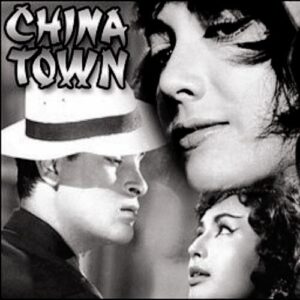 With China Town (1962), it was back to the familiar theme of a crime drama that was a super hit due to the fantastic music by Ravi. The jazz-based Baar Baar dekho has club singer Shekhar (Shammi Kapoor) praising the virtues of his girlfriend Rita (Shakila) to a club audience. Chasing Rita from Darjeeling to Calcutta, Shekhar disguises himself as a sadhu and sings Dekhoji ek baala jogi. Unused to opium and other addictions of Mike, Shekhar sings with Mike’s girlfriend Suzy (Helen), the high-energy Yamma yamma Tu parwana mai shama. The Calcutta Police asks Shekhar to infiltrate a criminal gang led by his lookalike Mike. Unused to opium and other addictions of Mike, Shekhar sings with Mike’s girlfriend Suzy (Helen), the high-energy Yamma Yamma Tu Parwana Main Shama.
With China Town (1962), it was back to the familiar theme of a crime drama that was a super hit due to the fantastic music by Ravi. The jazz-based Baar Baar dekho has club singer Shekhar (Shammi Kapoor) praising the virtues of his girlfriend Rita (Shakila) to a club audience. Chasing Rita from Darjeeling to Calcutta, Shekhar disguises himself as a sadhu and sings Dekhoji ek baala jogi. Unused to opium and other addictions of Mike, Shekhar sings with Mike’s girlfriend Suzy (Helen), the high-energy Yamma yamma Tu parwana mai shama. The Calcutta Police asks Shekhar to infiltrate a criminal gang led by his lookalike Mike. Unused to opium and other addictions of Mike, Shekhar sings with Mike’s girlfriend Suzy (Helen), the high-energy Yamma Yamma Tu Parwana Main Shama.
Ek Raaz (1963) was a bit of an oddity in that it had Kishore Kumar in a double role, with one of the earliest lost-and-found stories which became an epidemic in the early and mid-1970s. Chitragupta gave some lovely songs in his smooth style like Agar sun le to Ek naghma, Ajnabi se ban ke, Naghma e dil ko chhed ke, and Payalwali dekhna where Kishore proved that he was adept at singing Raga based songs.
Kashmir Ki Kali (1964) was Samanta’s first color film showing the audience Kashmir’s beauty. Junglee (1961) had already broken the “Kashmir barrier”, and soon movies were being filmed in Kashmir for no rhyme or reason. The wafer-thin story was about super-rich Rajiv, fleeing to Kashmir to find true love and meeting Champa (Sharmila Tagore in her first Hindi film). Every song in the movie is a gem. There are legendary stories about how O.P. Nayyar crafted them in long sessions with Shammi, Samanta, and the lyricist S.H.Bihari. Rajiv setting out to Kashmir has him singing Kisi na kisi se kabhi na kabhi. Rajiv chases Champa across Dal Lake while singing Taarif karun kya uski. There are three excellent duets. Champa starts to like Rajiv and sings Isharon isharon me dil lene wale. Escaping from the villain, the duo participates in a village fair and sings the robust bhangra-based Haay Re Haay ye mere haath me tera haath. But the killer duet is clearly when Rajiv takes leave of Champa with a promise to get engaged to her while singing Deewana hua badal. A shocked Rajiv learning his origins and losing Champa sings Hai Duniya Usi Ki. The film was a super hit, boosted by such superb music.
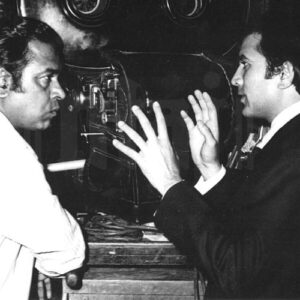 1966, Sawan Ki Ghata was another super hit helped by a semi-mystery angle. Shot in and around Darjeeling, the film was about Gopal (Manoj Kumar) rekindling his romance with childhood sweetheart Seema (Sharmila Tagore). There are flies in the ointment who don’t want the affair to proceed. The initial meeting with Gopal and the haughty Seema provokes Gopal to sing Zulfon ko hataa ley chehre se. Later, when Seema is angry with him, Gopal sings Meri jaan tumpe sadke Ehsan itna kardo. The song is repeated by Seema when she and Gopal have issues later in the story. Gopal is pursued by a local lass Saloni (Mumtaz), who thinks Gopal loves her when she sings Aaj koi pyar se dil ki baatein keh gaya. O.P.Nayyar always had a fondness for the 2-4 beat, due to which he was always dismissed as a “Ghoda-Gaadi” composer. However, Zara haule haule chalo morey sajna has Seema teasing Gopal, while they travel on a horse carriage.
1966, Sawan Ki Ghata was another super hit helped by a semi-mystery angle. Shot in and around Darjeeling, the film was about Gopal (Manoj Kumar) rekindling his romance with childhood sweetheart Seema (Sharmila Tagore). There are flies in the ointment who don’t want the affair to proceed. The initial meeting with Gopal and the haughty Seema provokes Gopal to sing Zulfon ko hataa ley chehre se. Later, when Seema is angry with him, Gopal sings Meri jaan tumpe sadke Ehsan itna kardo. The song is repeated by Seema when she and Gopal have issues later in the story. Gopal is pursued by a local lass Saloni (Mumtaz), who thinks Gopal loves her when she sings Aaj koi pyar se dil ki baatein keh gaya. O.P.Nayyar always had a fondness for the 2-4 beat, due to which he was always dismissed as a “Ghoda-Gaadi” composer. However, Zara haule haule chalo morey sajna has Seema teasing Gopal, while they travel on a horse carriage.
An Evening in Paris (1967) was simply a super hit. Of course, the main star is the foreign locations the audience could gawk at for a few annas. Shyam (Shammi Kapoor) introduces the audience to the wonder of Paris with Aji aisa mauka phir kahan milega. To counter Deepa’s (Sharmila Tagore) fake allegation that Indian men are faithless, Shyam acting as Sam Cooper chases her all over Europe. First, it is across Paris with Deewane ka naam to poocho. Then it is in Switzerland with Akeley akeley kahaan jaa rahey ho. Then he chases her to Beirut, swinging from a helicopter. At the same time, she is water skiing, while Shammi is singing the super hit Aasman se aaya farishta. Finally, when she relents, they run across Paris while he sings Mera Dil hai tera dil hai mera. The lovers serenade each other across the Seine while singing Raat ke humsafar thakke ghar ko chaley. It was a travelogue with a crime angle and a long-lost twin sister Roopa which dragged on the proceedings, yet the film was a super hit. If it seemed that Samanta had reached a peak, the best was yet to come.
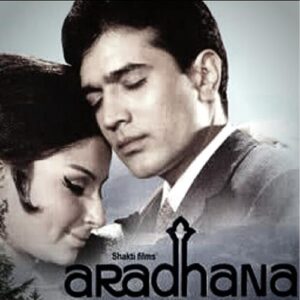 1969 and Aradhana happened . It gave Kishore Kumar a second life as a playback singer that saw him ascending new heights in the 1970s. It brought super stardom to Rajesh Khanna, even though the film was a classic three-hankie weepie about an unwed mother struggling to do the best for her son and making him an Air Force pilot. Rajesh Khanna played both father and son. An entire issue can be dedicated to the phenomenon of Aradhana and how each song forwarded the story or fit perfectly in the situation. It is best to take just three examples. The film starts as a flashback when Vandana (Sharmila Tagore) remembers how she met Flight Lt. Arun (Rajesh Khanna). While she sat in the window seat of the Darjeeling-bound narrow-gauge train, he rode the parallel road on a jeep singing Mere sapnon ki rani kab aayegi tu. The song was a super hit and stayed on the charts for a long time. Arun tells Vandana about his feelings while singing in the lush Darjeeling countryside Kora kaagaz tha ye man mera. The two lovers land in a hotel and dry their wet clothes. In an adjacent room, a man is singing to his beloved a lust-filled song Roop tera mastana pyar mera diwana. Arun and Vandana circle the fire, trying to come to terms with their lustful feelings while the song continues. This is brilliant filmmaking as the entire song is shot in one continuous take with a hand-held camera. The lovers gaze at each other and want to explore each other. Still, all the past restrictions are coming in their way with rok raha hai humko zamana, door hi rehna paas na aana . The song was also on the charts for a long time and is popular today too. The soundtrack, Rajesh Khanna, and a revived Kishore Kumar contributed to the film having a diamond jubilee run in Bombay’s Roxy theatre.
1969 and Aradhana happened . It gave Kishore Kumar a second life as a playback singer that saw him ascending new heights in the 1970s. It brought super stardom to Rajesh Khanna, even though the film was a classic three-hankie weepie about an unwed mother struggling to do the best for her son and making him an Air Force pilot. Rajesh Khanna played both father and son. An entire issue can be dedicated to the phenomenon of Aradhana and how each song forwarded the story or fit perfectly in the situation. It is best to take just three examples. The film starts as a flashback when Vandana (Sharmila Tagore) remembers how she met Flight Lt. Arun (Rajesh Khanna). While she sat in the window seat of the Darjeeling-bound narrow-gauge train, he rode the parallel road on a jeep singing Mere sapnon ki rani kab aayegi tu. The song was a super hit and stayed on the charts for a long time. Arun tells Vandana about his feelings while singing in the lush Darjeeling countryside Kora kaagaz tha ye man mera. The two lovers land in a hotel and dry their wet clothes. In an adjacent room, a man is singing to his beloved a lust-filled song Roop tera mastana pyar mera diwana. Arun and Vandana circle the fire, trying to come to terms with their lustful feelings while the song continues. This is brilliant filmmaking as the entire song is shot in one continuous take with a hand-held camera. The lovers gaze at each other and want to explore each other. Still, all the past restrictions are coming in their way with rok raha hai humko zamana, door hi rehna paas na aana . The song was also on the charts for a long time and is popular today too. The soundtrack, Rajesh Khanna, and a revived Kishore Kumar contributed to the film having a diamond jubilee run in Bombay’s Roxy theatre.
Pagla Kahin Ka (1970) had a disjointed story about the hero pretending to be mad and then really becoming mad. Shammi Kapoor was on a downward slide, and the audience rejected the film. There was a superb romantic song Tum mujhey yoon bhula na paoge, and the robust title song Log kahey Mujhe pagla kahin ka.
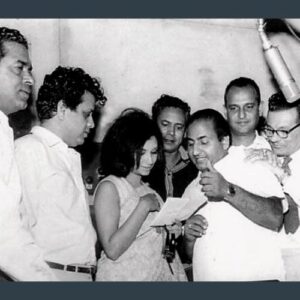 If Pagla Kahin Ka flopped, Kati Patang in the same year was a super hit. Once again, the Rajesh Khanna-Kishore Kumar combo came into its own under the baton of R.D. Burman. This trio was to prove a formidable hit machine till the mid-1970s. The film’s first song is the drunken rambling of Yeh jo Mohabbat hai, where Kamal (Rajesh Khanna) advises his audience never to fall in love. As he gets attracted to “widow” Madhu (Asha Parekh), he sings the romantic Pyar diwana hota hai mastana hota hai. Out in the open spaces with close friends, Kamal openly declares Mujhey dor koi kheenche while singing Yeh Shaam mastani. However, the usual “item song” of those days – basically a cabaret number by the vamp – actually has a story. While Shabnam the dancer sings Mera Naam hai Shabnam, she also asks Madhu what’s her real name. This is superb singing and picturization, resulting in “Madhu” walking out of the club, much to Kamal’s confusion.
If Pagla Kahin Ka flopped, Kati Patang in the same year was a super hit. Once again, the Rajesh Khanna-Kishore Kumar combo came into its own under the baton of R.D. Burman. This trio was to prove a formidable hit machine till the mid-1970s. The film’s first song is the drunken rambling of Yeh jo Mohabbat hai, where Kamal (Rajesh Khanna) advises his audience never to fall in love. As he gets attracted to “widow” Madhu (Asha Parekh), he sings the romantic Pyar diwana hota hai mastana hota hai. Out in the open spaces with close friends, Kamal openly declares Mujhey dor koi kheenche while singing Yeh Shaam mastani. However, the usual “item song” of those days – basically a cabaret number by the vamp – actually has a story. While Shabnam the dancer sings Mera Naam hai Shabnam, she also asks Madhu what’s her real name. This is superb singing and picturization, resulting in “Madhu” walking out of the club, much to Kamal’s confusion.
1971’s Jaane-Anjaane was indeed the last hurrah for the Shakti-Shammi-Shankar Jaikishan combo. Yet another variation of the lost and found formula, the film had newcomer Vinod Khanna playing a cop (and long-lost brother) to Shammi Kapoor’s criminal. Once again, the improbable story and the insipid songs resulted in another flop.
1971 had another super hit with yet another Rajesh Khanna-Kishore Kumar-R.D.Burman offering in Amar Prem. R.D.Burman gave one of his finest Raga-based scores in this film but lost the Filmfare award to the ridiculous Jai bolo beiman ki. Cynics and humourists say this is a straightforward celebration of the beimani of the awards, where awards could be bought! Lata sang the Raag Todi-based Raina beeti jaaye. Kishore had three super hits with Yeh kya hua Raag Khamaj based Kuchh to log Kahenge and the superb Bhairavi based Chingari koi bhadke, each lending pathos to the onscreen proceedings.
Anuraag (1972) was successful as it was one more “cancer movie” that was a minor trend in the early 1970s. Here it is a young boy, Chandan (Master Satyajeet), who is the family’s favorite. He becomes friendly with a blind woman Shivani (Moushumi Chatterjee), who is romanced by Rajesh(Vinod Mehra), the son of a miser. Rajesh Khanna, in a special appearance as a shopkeeper Gangaram, got one song. However, both Sun Ri Pawan where Chandan meets Shivani for the first time and Neend churaye chain churaye when Rajesh falls in love with her is based on S.D. Burman’s Bengali tunes and picturized beautifully. There is a classic ‘call and answer” style tune in Tere nainon ke mai deep jalaunga where Rajesh promises to help Shivani see the world thru his eyes.
 Ajanabee (1974) was yet another hit based on the Rajesh Khanna-Kishore-Pancham combo providing super hit music. The film was a cross between a murder mystery and a romance. While Ek ajnabee haseena se is about unraveling the clues as to the mysterious woman Rohit met, the growing romance between Rohit and Rashmi leads to them frolicking in the rain with Bheegi bheegi raaton mein a song that is popular with the 21st-century generation too.
Ajanabee (1974) was yet another hit based on the Rajesh Khanna-Kishore-Pancham combo providing super hit music. The film was a cross between a murder mystery and a romance. While Ek ajnabee haseena se is about unraveling the clues as to the mysterious woman Rohit met, the growing romance between Rohit and Rashmi leads to them frolicking in the rain with Bheegi bheegi raaton mein a song that is popular with the 21st-century generation too.
Charitraheen was another 1974 release with a 1950s-style story of the heroine forced into prostitution due to circumstances. The married hero runs into her later, and the whispering campaign starts against him. Since the emphasis was on a “social message”, the film was a modest success but not before R.D.Burman left us with a lovely Raag Pahadi-based duet when the young lovers meet. Dil se dil milne ka was shot across the lanes and by lanes of unspoiled Simla. Rama now known as Rosy sings Teri meri yaari in a nightclub to a shocked Inder while referring to the years gone by.
Amanush was made in both Hindi and Bengali with the same star cast and saw Bengali superstar Uttam Kumar return to Hindi cinema after a long gap. This 1975 release was a success in both languages, no doubt due to the stunning music by Shyamal Mitra in both versions. The story of a man hounded by the village into being the village ruffian and fighting for his rights alone echoed the common man in the turbulent mid-1970s. The title song Dil aisa kisi ne mera toda has Madhu (Uttam Kumar) singing the song on a boat, sailing in the Bengal backwaters. At the same time, his estranged love Lekha (Sharmila Tagore), watches silently. The Bengali version of the same song Kee ashai bandhi khelaghor is equally, if not more, poignant. The film was remade in Telugu, Tamil, and Malayalam, proving that it was a human story that found appeal across India.
Sooner or later, the law of averages starts catching up with everyone in any field of human endeavor. Samanta had been on a continuous streak of success since the early 1960s. Mehbooba was released in 1976 and was a super flop. Rajesh Khanna was also on a downward career graph, and the film came in that phase. The audience rejected the tired story of reincarnation and star-crossed lovers across hundreds of years despite a stunning Shivranjani-based Mere Naina sawan bhadon with the male version by Kishore being quite popular.
1977 saw two releases – Anurodh and Ananda Ashram, in Hindi and Bengali. Anurodh was a moderate success thanks to the music, this time by Laxmikant Pyarelal in excellent form with Aapke anurodh pe, Aate jaate khoobsurat, Jab Dard nahi tha seene mein. The songs were decent but didn’t appeal to the Hindi audience. The audience couldn’t relate to Rajesh Khanna romancing his real-life sister-in-law, Simple Kapadia, onscreen and having no romantic duets with the heroine. Anand Ashram tried to repeat the magic of the Uttam Kumar-Sharmila pairing of Amanush, but the magic was missing. The story of a doctor treating the rural poor belonged in the 1950s and 1960s and didn’t find any appeal with modern audiences.
The Great Gambler (1979) was Samanta’s first work with Amitabh Bachchan, who was on a roll in the mid to late 1970s. The film had a troubled production for various reasons, including villain Amjad Khan’s severe injuries in a road accident, leaving him out of the film and being replaced by Utpal Dutt. Added to that was the story of long-lost twin brothers, and the film did poorly at the box office.
In Khwab (1980), Samanta went beyond his usual team, resulting in another box office flop.
1981’s Barsaat Ki Ek Raat was a hit due to the Bachchan mania. The tired old story of a cop coming into a rural hillside town to clean it up was utterly predictable, yet the film was a hit. R.D. Burman was in modest form, giving one hit song Apne pyar ke sapne sach huey.
The downward slide was evident in the 1980s. Ayaash (1982) was a flop due to its old story of feudal rulers and the ruled, set in British India. Awaaz (1984), a revenge drama, saw Rajesh Khanna returning to Samanta and was a modest success. Aar Paar (1985) was an Indo-Bangla Desh production that was a modest success. 1985’s Alag Alag found Samanta reuniting with Rajesh Khanna, who had turned producer and trying to recreate the magic with the Kishore-Pancham combo, but that too sank without a trace. However, the songs did get some airplay. Dushman (1990) and Geetanjali (1993) were the last hurrahs.
The late 1950s, 1960s, and mid-1970s were his best period, where one musical hit after another resulted in a basket of evergreen music. We can perhaps look back on those films, be awed at how well the music fit into the usually wafer-thin story and say Baar Baar Dekho.




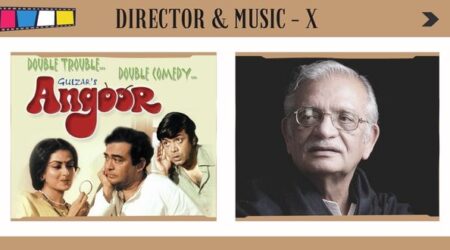

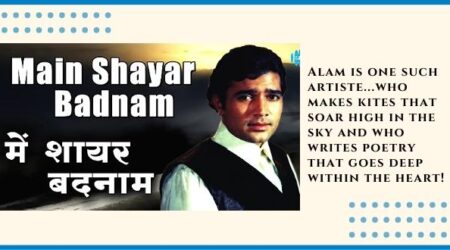



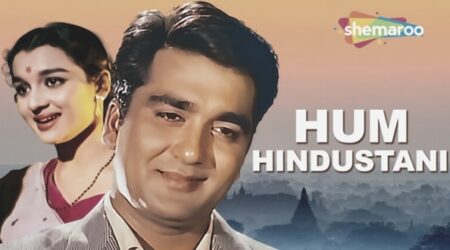



Comments (5)
Excellent research, very well written
Great write-up. Thanks for taking us down memory lane, Ramesh. Yes, the sheer volume of films by Shakti Samanta and brilliant music in those films is amazing. Kati Patang (1971) deserved the Filmfare Best Music award, but the beimaan and clever Filmfare awards committee did not even nominate it among top 3 of that year ostensibly to manipulate votes in favor of the 3 films that were nominated. They did it in 1978 too when they did not nominate Muqaddar Ka Sikandar (best music of the year) among top 5. Talking about Mehbooba (1976), you mentioned only one song ‘mere naina’ which was unfair to this fabulous musical score which boasted other gems too, like ‘parbat ke peechhe’, ‘nadiya ke kinaare’, and ‘gori tori paijaniya’. About Anurodh (1977), you say ‘The songs were decent but didn’t appeal to the Hindi audience’ – I do not agree. The songs were superb and did appeal to the Hindi audience. Both ‘aapke anurodh pe’ and ‘aate jaate khoobsoorat’ were very popular in 1977 and ranked highly in annual Binaca Geetmala show of the year. Although I greatly enjoyed reading this post, I was disappointed that you did not mention any song from The Great Gambler (1979) when this series of your posts is about the director and the music. The Great Gambler remains among RD Burman’s finest music scores. I still cannot get enough of the lively ‘pehle pehle pyaar ki’, the serene ‘do lafzon ki hai’, the exotic ‘raqqasha mera naam’, the scintillating ‘o deewaanon’, and the superb ‘tum itne baad mile’. Shakti Samanta indeed lost his touch in the ’80s and delivered duds after duds. However, you wrapped your post with just cursory mention of his films form the ’80s though a few of them did have decent songs, for example, ‘tuu hi wo haseen hai’ (Khwaab), ‘dil mein aag lagaaye’ (Alag Alag), and ‘o maajhi’ (Aar Paar). Keep up the good work.
Thank you for your comments. I left put the 1980s as generally – as you rightly said – it was duds after duds.
Thank you for your comments. I didn’t focus too much on the 1980s as generally – as you rightly said – it was duds after duds.
Thanks, Ramesh for this lovely write up on Shakti Samantha. A real herculean effort!
Continue to write more.